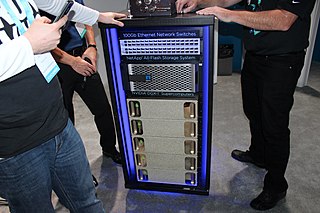Related Research Articles

A supercomputer is a computer with a high level of performance as compared to a general-purpose computer. The performance of a supercomputer is commonly measured in floating-point operations per second (FLOPS) instead of million instructions per second (MIPS). Since 2017, there have existed supercomputers which can perform over 1017 FLOPS (a hundred quadrillion FLOPS, 100 petaFLOPS or 100 PFLOPS).

A graphics processing unit (GPU) is a specialized electronic circuit designed to manipulate and alter memory to accelerate the creation of images in a frame buffer intended for output to a display device. GPUs are used in embedded systems, mobile phones, personal computers, workstations, and game consoles.
General-purpose computing on graphics processing units is the use of a graphics processing unit (GPU), which typically handles computation only for computer graphics, to perform computation in applications traditionally handled by the central processing unit (CPU). The use of multiple video cards in one computer, or large numbers of graphics chips, further parallelizes the already parallel nature of graphics processing.
Tesla most commonly refers to:

A GPU cluster is a computer cluster in which each node is equipped with a Graphics Processing Unit (GPU). By harnessing the computational power of modern GPUs via General-Purpose Computing on Graphics Processing Units (GPGPU), very fast calculations can be performed with a GPU cluster.
AMD FireStream was AMD's brand name for their Radeon-based product line targeting stream processing and/or GPGPU in supercomputers. Originally developed by ATI Technologies around the Radeon X1900 XTX in 2006, the product line was previously branded as both ATI FireSTREAM and AMD Stream Processor. The AMD FireStream can also be used as a floating-point co-processor for offloading CPU calculations, which is part of the Torrenza initiative. The FireStream line has been discontinued since 2012, when GPGPU workloads were entirely folded into the AMD FirePro line.
A personal supercomputer (PSC) is a marketing ploy used by computer manufacturers for high-performance computer systems and was a popular term in the mid 2000s to early 2010s. There is no exact definition for what a personal supercomputer is. Many systems have had that label put on them like the Cray CX1 and the Apple Power Mac G4. Generally, though the label is used on computers that are High end Workstations and Servers and have multiple processors and is small enough to fit on a desk or to the side. Other terms like PSC are Desktop/deskside supercomputers and supercomputers in a box.

The Irish Centre for High-End Computing (ICHEC) is the national high-performance computing centre in Ireland. It was established in 2005 and provides supercomputing resources, support, training and related services. ICHEC is involved in education and training, including providing courses for researchers.
The Cray CX1 is a deskside high-performance workstation designed by Cray Inc., based on the x86-64 processor architecture. It was launched on September 16, 2008, and was discontinued in early 2012. It comprises a single chassis blade server design that supports a maximum of eight modular single-width blades, giving up to 96 processor cores. Computational load can be run independently on each blade and/or combined using clustering techniques.

The Fastra II is a desktop supercomputer designed for tomography. It was built in late 2009 by the ASTRA group of researchers of the IBBT VisionLab at the University of Antwerp and by Belgian computer shop Tones, in collaboration with Asus, a Taiwanese multinational computer product manufacturer, as the successor to the Fastra I.
SAGA-220 is a supercomputer built by the Indian Space Research Organisation (ISRO).

Tsubame is a series of supercomputers that operates at the GSIC Center at the Tokyo Institute of Technology in Japan, designed by Satoshi Matsuoka.
The Cray XK6 made by Cray is an enhanced version of the Cray XE6 supercomputer, announced in May 2011. The XK6 uses the same "blade" architecture of the XE6, with each XK6 blade comprising four compute "nodes". Each node consists of a 16-core AMD Opteron 6200 processor with 16 or 32 GB of DDR3 RAM and an Nvidia Tesla X2090 GPGPU with 6 GB of GDDR5 RAM, the two connected via PCI Express 2.0. Two Gemini router ASICs are shared between the nodes on a blade, providing a 3-dimensional torus network topology between nodes. This means that it has 576 GB of Graphics memory and over 1500 CPU cores, several orders of magnitude more powerful than the best publicly available computer on the market.

Nvidia Tesla was the name of Nvidia's line of products targeted at stream processing or general-purpose graphics processing units (GPGPU), named after pioneering electrical engineer Nikola Tesla. Its products began using GPUs from the G80 series, and have continued to accompany the release of new chips. They are programmable using the CUDA or OpenCL APIs.

NVLink is a wire-based serial multi-lane near-range communications link developed by Nvidia. Unlike PCI Express, a device can consist of multiple NVLinks, and devices use mesh networking to communicate instead of a central hub. The protocol was first announced in March 2014 and uses a proprietary high-speed signaling interconnect (NVHS).
Volta is the codename for a GPU microarchitecture developed by Nvidia, succeeding Pascal. It was first announced on a roadmap in March 2013, although the first product was not announced until May 2017. The architecture is named after 18th–19th century Italian chemist and physicist Alessandro Volta. It was NVIDIA's first chip to feature Tensor Cores, specially designed cores that have superior deep learning performance over regular CUDA cores. The architecture is produced with TSMC's 12 nm FinFET process. The Ampere microarchitecture is the successor to Volta.
Single instruction, multiple threads (SIMT) is an execution model used in parallel computing where single instruction, multiple data (SIMD) is combined with multithreading. It is different from SPMD in that all instructions in all "threads" are executed in lock-step. The SIMT execution model has been implemented on several GPUs and is relevant for general-purpose computing on graphics processing units (GPGPU), e.g. some supercomputers combine CPUs with GPUs.
Digital signal processing (DSP) is a ubiquitous methodology in scientific and engineering computations. In practice, DSP problems are often not only one dimensional. For instance, image data is a 2-D signal and radar is a 3-D signal. While the number of dimensions increases, the time and/or storage complexity of processing digital signals grow dramatically. Therefore, solving multidimensional DSP problems in real-time is extremely difficult.

Nvidia DGX is a line of Nvidia-produced servers and workstations which specialize in using GPGPU to accelerate deep learning applications. The typical design of a DGX system is based upon a rackmount chassis with motherboard that carries high performance x86 server CPUs. The main component of a DGX system is a set of 4 to 16 Nvidia Tesla GPU modules on an independent system board. DGX systems have large heatsinks and powerful fans to adequately cool thousands of watts of thermal output. The GPU modules are typically integrated into the system using a version of the SXM socket.

AMD Instinct is AMD's brand of professional GPUs. It replaced AMD's FirePro S brand in 2016. Compared to the Radeon brand of mainstream consumer/gamer products, the Instinct product line is intended to accelerate deep learning, artificial neural network, and high-performance computing/GPGPU applications.